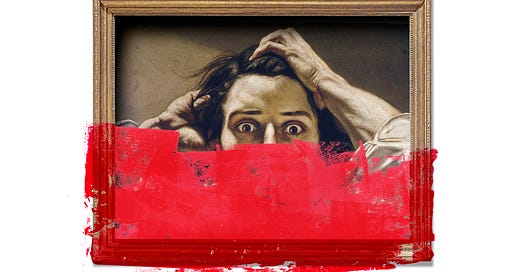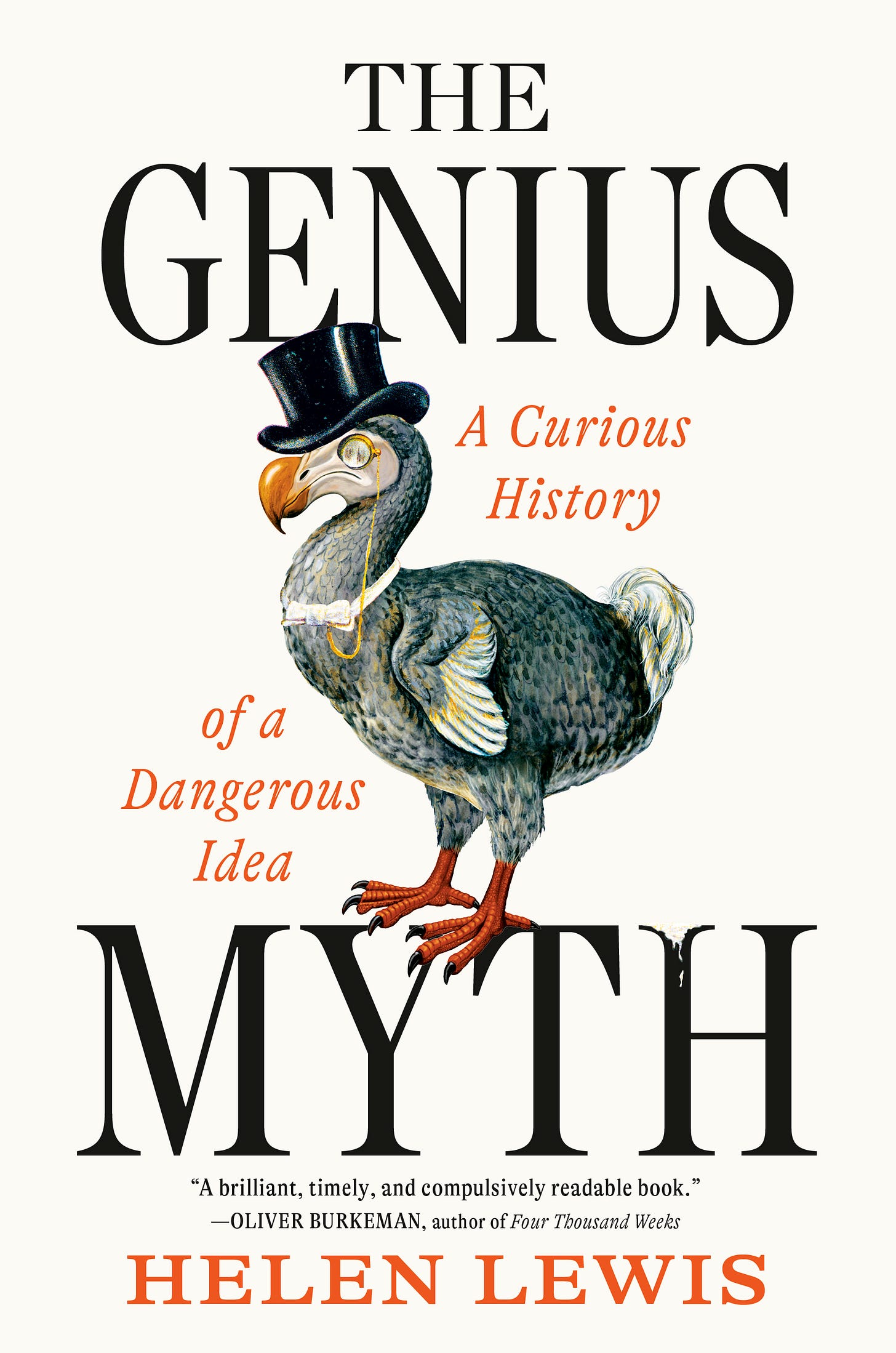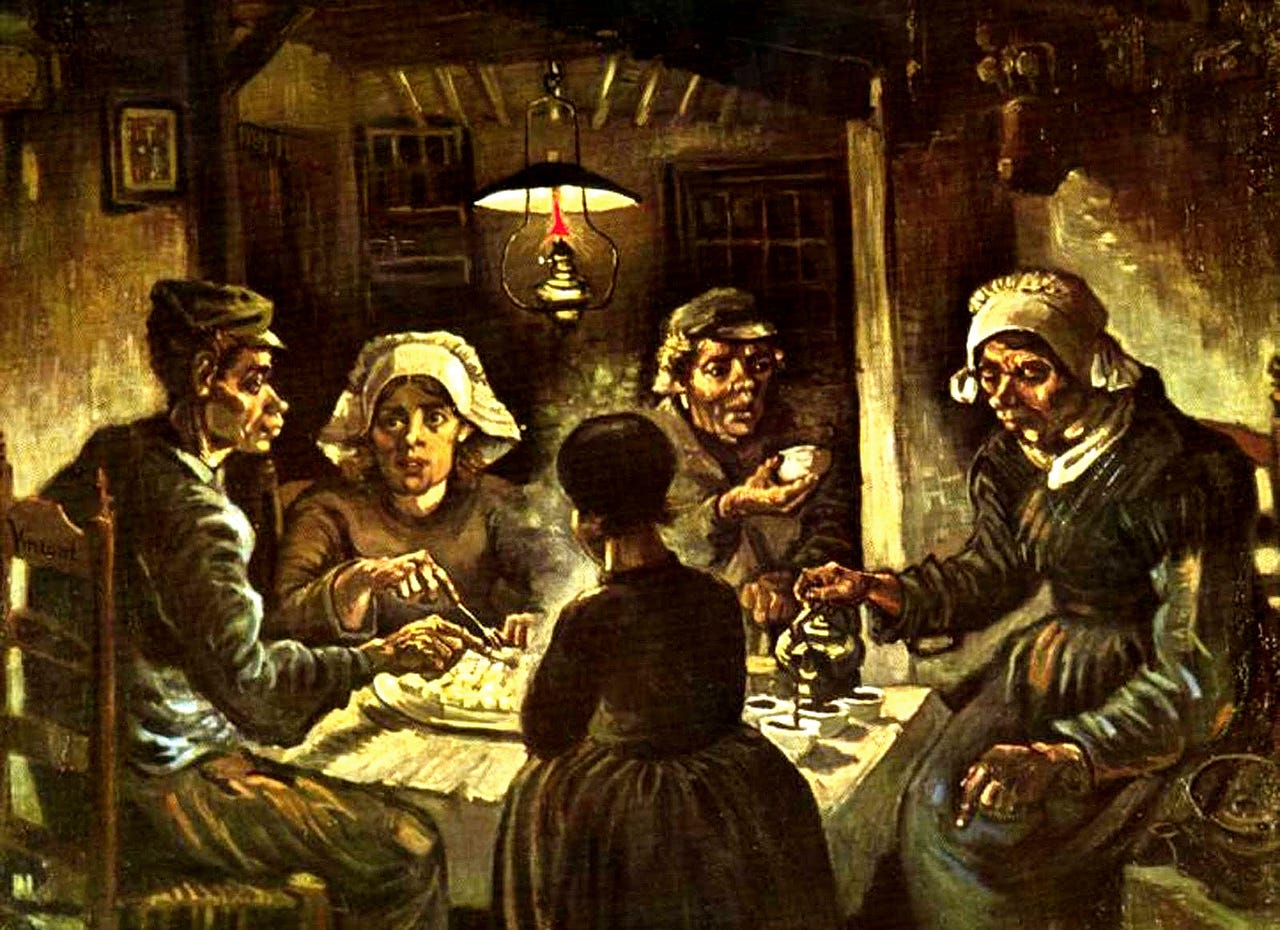Happy Friday!
My big news this week is that we have agreed the covers for The Genius Myth, which will published in June. Seeing the cover design for the first time really is the best part of writing a book, because a) it makes the book feel proper, somehow; b) someone else is doing all the work.
First up is the UK edition (pre-order here), featuring a painting by Gustave Courbet called “Le Désespéré”, a self-portrait as a despairing young artist. Courbet is also responsible for a rather explicit picture called “L’Origine du Monde” that is a highlight of any visit to the Musee D’Orsay in Paris.
I love this cover because it captures the essence of the book — I am looking at well-established stories and, well, scribbling in the margins.
And here is the cover for the US edition, which is now available to pre-order in the United States:
Why a dodo? Because the idea of a genius — a special, superior sort of person — has been declared dead. (Thomas Carlyle’s famous Victorian essay on “Great Men” was explicitly countercultural; he was writing to rehabilitate the concept of hero-worship.) And yet, like this particular dodo, that idea is very much alive. We still crave heroes and idols and secular saints.
Also, quite honestly, I just love this illustration. Where is the dodo going dressed like this, the opera?
You’ll notice we have a different subtitles in the US and UK . . . I’m intrigued to see how that affects perceptions of the book.
Helen
PS. Nominations for what the dodo would be called can be made in the comments.
PPS. If you simply cannot wait to read my new book, then the old one is currently 99p on Kindle.
Crazy Vinnie (The Guardian, 2005)
Perhaps no artist who got as good as Vincent has ever started out so bad. Not just bad, but worthy bad, which is (if anything) worse. Even today, you'd hardly want one as a present, unless it was from someone you didn't want to offend. Those dogged, I-share-your-suffering images of ground-down peasant women and Dutch cloggies grouped around the sacramental potato, done in glum, awkward homage to Jean-François Millet and English social-consciousness painters such as Luke Fildes, all testify that sincerity, on its own, is not an artistic virtue. Gazing at early Van Gogh, at that murky stuff from the mid-1880s, you thirst for some signs of style — and there are none, or none that count.
And yet the amazing fact — and it has never ceased to be amazing, which is one of the components of the Van Gogh myth - is that this earnest duffer pupated into one of the great visionaries of western art, and did so across a working life of hardly more than 10 years. Most of its greatest achievements were compressed into four years, between 1886, when he first caught sight of the paintings of Georges Seurat in Paris, and 1890, when he shot himself to death in a cornfield at Auvers sur Oise, just north of Paris.
It is difficult to get anywhere near Van Gogh today. There are obstructions. The main one used to be his reputation as Crazy Vinnie the Ear-Slasher. . . . Decades after his death, when the crude stereotype of the "mad artist" receded, it was replaced by something even more toxic: the artist as an incontinent Midas, who could not touch anything without making it ludicrously valuable and hence, as art, virtually meaningless. After the market insanities of the 1980s and 1990s, will anyone be able to look at Van Gogh's sunflowers, his irises or his portrait of his therapist, Dr Gachet, without seeing the price first and the picture second? It is a form of radioactivity that never decays.
*
There’s a chapter on Van Gogh in The Genius Myth, partially because he is my favourite artist—it was such a pleasant surprise to go to the recent National Gallery show and discover that someone so universally feted is still, nonetheless, not over-rated. But I also wanted to write about him because mythology is such a huge part of his story, as Robert Hughes outlines in this review of his drawings. I’m afraid I reluctantly agree with Hughes that his early stuff absolutely sucked. Bold to have a go at using so much brown, but ultimately misguided.
We don’t talk much about what I think is the most interesting facet of Van Gogh’s work—the influence of Japanese woodcuts on the colours and compositions in his later work. Instead the public discussion alternates between “crazy Vinnie, always chopping off ears” and “they paid WHAT for those sunflowers”. Sadly, to be hailed as an artistic genius, you have to be subsumed within a larger mythology. As for who created that mythology in Van Gogh’s case . . well, you’ll have to buy the book to find out.
PS. I really can’t stress enough that Hughes isn’t lying about how bad early Van Gogh is. Look this horror! It’s like that picture of dogs playing poker, except ALL IN BROWN. There is hope for us all.
(Thanks to James Marriott’s Substack for the tip.)
How The British Broke Their Own Economy (The Atlantic, gift link)
Under Prime Minister Margaret Thatcher, the Conservatives rolled back nationalization in several areas, such as electricity and gas production. But their efforts to loosen housing policy from the grip of government control was a tremendous failure, especially once it was revealed that Thatcher’s head of housing policy himself opposed new housing developments near his home.
Housing is, as I’ve written, the quantum field of urban policy, touching every station of urban life. Broken housing policies have a ripple effect. In London, Bowman said, the most common options are subsidized flats for the low-income and luxury units for the rich, creating a dearth of middle-class housing. As a result, the city is bifurcated between the über-wealthy and the subsidized poor. “I think housing policy is a major driver of a lot of anti-foreigner, white-supremacist, anti-Black, anti-Muslim attitudes among young people who are frustrated that so-called these people get free houses while they have to live in a bedsit or move somewhere an hour outside the city and commute in,” [Sam] Bowman said.
*
This newsletter has very few strong political opinions, but one of them is that you can’t solve any of Britain’s political problems without fixing its housing crisis.
This piece by Derek Thompson echoes the argument in my colleague Yoni Appelbaum’s book Stuck — that people on the left, who want refugees and migrants to be accepted by society, need to accept that new arrivals means increased demand for housing. You can’t be a progressive NIMBY. Or rather you can, clearly, because lots of people are. But it’s a self-defeating position.
Quick Links
“He claims to have had a conversation with the ghost of Ayn Rand in a Buenos Aires bookshop. He has four dogs, all named after libertarian economists (‘Milton’ for Milton Friedman). He believes them to have special powers and is said to seek their advice on political strategy. They are all cloned from a fifth dog, his beloved Conan (after the Barbarian), who died in 2017.” Ian Leslie on whether the mad prosper in politics (Substack)
Here’s a game where every day you get a prompt and you have to draw it to the best of your ability in a 16 x 16 pixel square. I thought I made a pretty good fist of “eraser” after seeing the link in Web Curios.
Amid all the crazy news from America in the last few weeks, you might have missed the fact that Romania lifted a travel ban on Andrew and Tristan Tate, after influential MAGA people took up their cause. Update regarding Muslims accused of grooming: fine people, please take a private jet to Florida. I wrote about it for The Atlantic (gift link).
“The Democratic Party desperately needs a reckoning. It needs someone of stature who will say out loud how profoundly the party has gone astray—someone who will be listened to. Shapiro could be that person—many in the party want him to be—the way Bill Clinton was as governor of Arkansas when the Democrats were trying to find their footing after the Republicans dominated the 1980s. The problem is that [Josh] Shapiro is unwilling to assume that role.” Well, you say that, the Free Press, but—he is giving interviews to the Free Press. I think he’s at least reckoning-curious.
“My advice to Meghan, not that she would ever listen, would be to get a terrific accountant, cut her outgoings dramatically and downsize.” Esther Walker tries to be generous to With Love, Meghan. My main comment is that those who do not read the coverage of Pippa Middleton are condemned to repeat it (The Spike, Substack)
“Discovering these facts radically changed my impression of why, per the writer’s written communication with me, she was not asked for the purpose of a $50,000 withdrawal by any bank staff.” Remember that viral essay about a woman who was a financial advice columnist, and nonetheless managed to get scammed out of $50,000 that she handed over in a shoebox to some rando who said he was from the FBI? Patrick Mckenzie didn’t believe it happened, so he spent money (and his own money) trying to fact-check it. The TLDR is that it is indeed unbelievable that a bank would hand over $50,000 to a regular customer with no checks. But the “financially insecure freelance journalist” who wrote the piece turns out to live in a $$$ apartment and have family money (Bits About Money).
See you next time! If you were forwarded this email and would like to subscribe for a weekly digest of links and commentary, hit the button below.








Both covers are great but the Dodo one is properly fantastic!
"My main comment is that those who do not read the coverage of Pippa Middleton are condemned to repeat it." It's asides like this that keep me coming back.